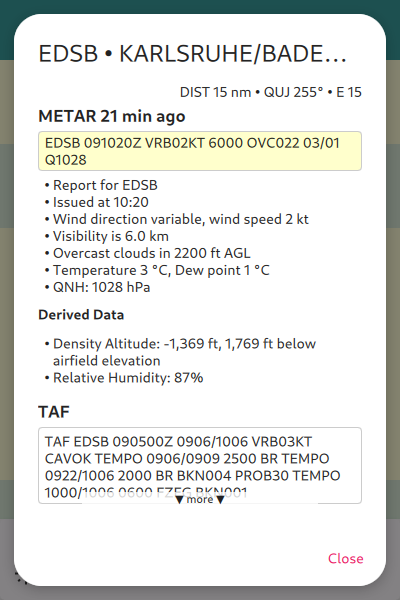METAR and TAF Dialog
Enroute Flight Navigation shows METAR reports and TAF forecasts using the following dialog.

METAR and TAF Dialog
This section describes the dialog window in detail.
Warning
The weather information shown by Enroute Flight Navigation might be outdated or otherwise wrong. Always use officially approved sources of flight weather information to assess of meteorological flight conditions.
Title and Subtitle
The title bar shows the name and ICAO identifier of the station whose METAR and TAF are shown. Identifiers are shown only if the window is wide enough.
If current positioning data is available, the window shows a subtitle line with directions for flight to the weather station. The section Direction Summary explains the direction line in more detail.
METAR Section
The METAR section starts with a headline that prominently displays the age of the METAR. The following data is shown further down.
Raw METAR Text
The raw METAR text is displayed in a box that is colored according to the “aviation flight categories” typically used in the United States. The coding scheme is explained in the table below. Note that this color coding might be different from the scheme typically used in your country. Green color does certainly not imply that it is advisable (or legal) to fly.
Category |
Color |
Ceiling |
Visibility |
|
|---|---|---|---|---|
low IFR |
Red |
<500 feet AGL |
or |
<1 statute mile |
IFR |
Red |
500 – 1,000 feet AGL |
or |
1 – 3 statute miles |
marginal VFR |
Yellow |
1,000 – 3,000 feet AGL |
or |
3 – 5 statute miles |
VFR |
Green |
>3,000 feet AGL |
and |
> 5 statute miles |
no data |
White |
– |
– |
– |
Decoded METAR Text
Enroute Flight Navigation is able to decode METAR texts. The decoded information is shown in the form of an itemized list.
We found that many METAR reports deviate from the standard format, often following national or local traditions to include additional data. While Enroute Flight Navigation includes a sophisticated decoding algorithm, it might fail to interpret every METAR report correctly.
Derived Data
For convenience, Enroute Flight Navigation shows a number of data items that are not directly contained in the METAR, but can be inferred from METAR data. If enough information is available, then the following data is presented under the headline “Derived Data”.
Density Altitude
The density altitude is computed using a rather sophisticated algorithm that takes QNH, airfield elevation, temperature and humidity into account. The value presented might therefore differ from rule-of-thumb estimates taught in flight schools. For details concerning our algorithm, check the source code of Enroute Flight Navigation, which is freely available on GitHub.
Relative Humidity
Relative humidity is computed using a standard formula from temperature and dew point information contained in METAR data.
Warnings Concerning Aircraft Performance
Warnings are shown if rule-of-thumb estimates suggest that density altitude degrades performance of typical SEP aircraft to a point where takeoff-distance increases by more than 25% or climb rates decreases by more than 25%, when compared to standard conditions at sea level.
Explanatory Text
Whenever warnings are shown, Enroute Flight Navigation also displays a brief explanatory text. The text contains hyperlinks that can be used to hide the explanatory text, or hide all performance warnings altogether. Use the Settings page to re-enable warnings after they have been switched off.
Enroute Flight Navigation uses the standard rule-of-thumb estimate that the takeoff-distance increases by 15% and the climb rate decreases by 7.5% for every 1,000 ft of density altitude. While this might be a reasonable estimate for typical SEP aircraft, it might be conservative for aircraft with a turbocharged engine.
Warning
Do not rely on Enroute Flight Navigation to assess aircraft performance. We do not guarantee that density altitude is computed correctly. The rule-of-thumb estimate for aircraft performance might not apply to your specific aircraft.
Density altitude and aircraft performance are safety-critical. While the number presented in Enroute Flight Navigation can give you a first impression, always use approved methods to compute density altitude for your locality. Always refer to the officially approved flight manual to assess aircraft performance.
TAF Section
The raw TAF text is displayed in a white box, followed by the decoded TAF text. As with METAR text, we cannot guarantee that Enroute Flight Navigation is able to decode every TAF correctly.